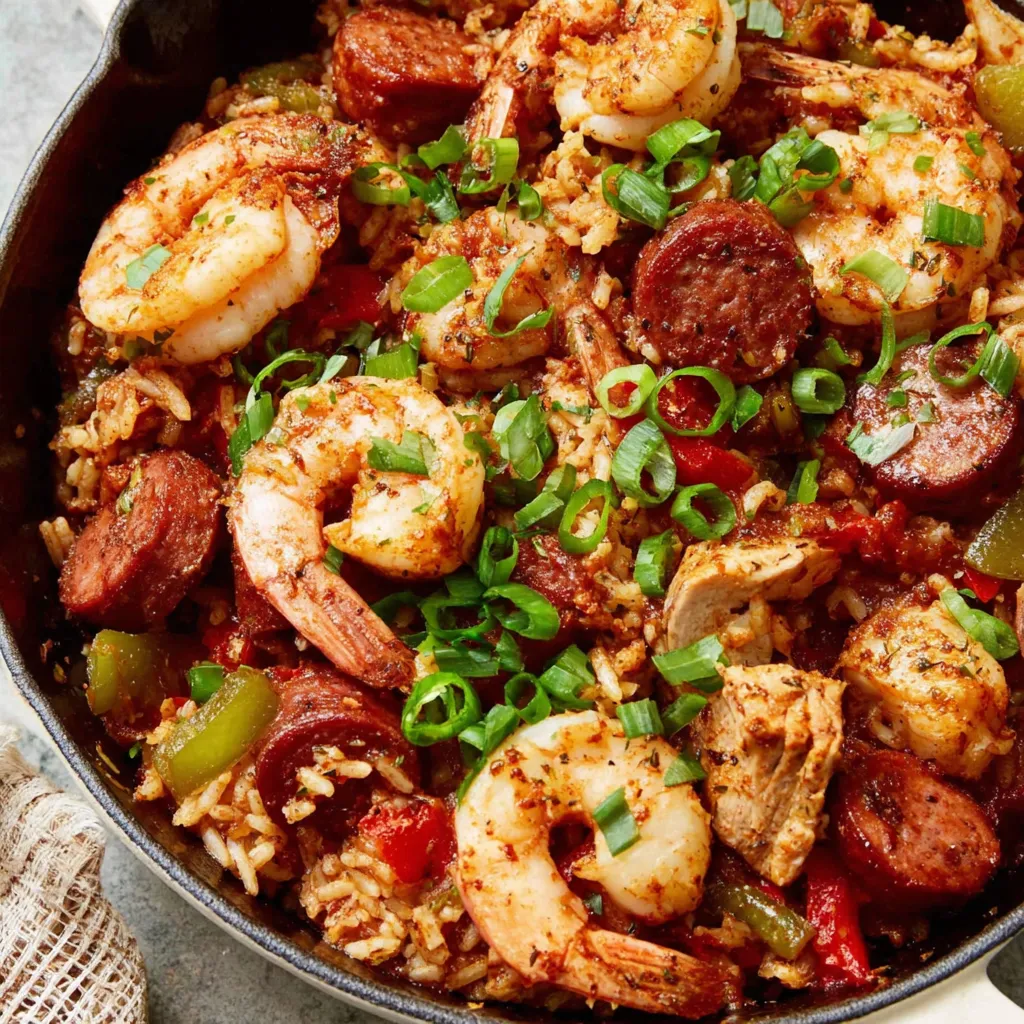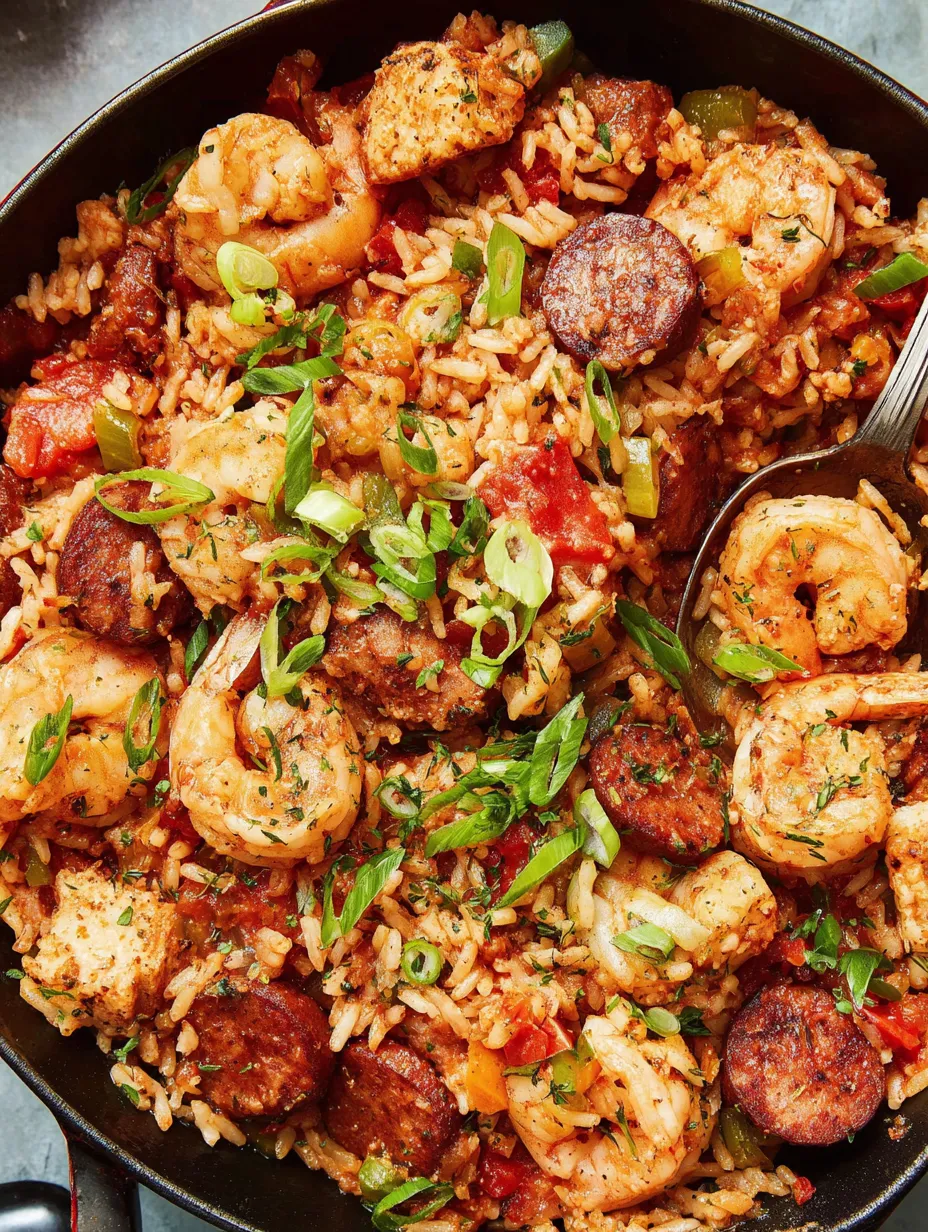 Pin it
Pin it
This jambalaya recipe finally solved my decade-long struggle with getting the rice right in this iconic Louisiana dish. I'd tried so many versions over the years that either turned into a mushy mess or left me with crunchy, undercooked grains scattered throughout. The breakthrough came when my college roommate's mom from New Orleans visited and watched me make it, then very politely suggested a few adjustments that completely transformed how I approached the whole process. Now I can make jambalaya that actually tastes like it belongs in the French Quarter, with perfectly tender rice that holds its shape, smoky andouille sausage, juicy chicken, and plump shrimp all dancing together in this incredible symphony of Cajun flavors that makes my kitchen smell like pure comfort.
My friend Tom from Louisiana tried this at a potluck last year and spent the entire evening asking detailed questions about my technique because he said it tasted exactly like his grandmother's version. Coming from someone who grew up eating the real thing every Sunday after church, that was probably the highest compliment my cooking has ever received. He even asked me to write down the recipe for his sister, who'd been struggling to recreate their family version since their grandmother passed away.
Essential Ingredients
- Boneless chicken thighs: Dark meat stays much more tender and flavorful than chicken breasts, especially important since this cooks for a while
- Real andouille sausage: Don't substitute with regular smoked sausage. Andouille has that distinctive smoky, spicy flavor that defines authentic jambalaya
- Long grain white rice: The starch content and cooking properties are crucial for getting the right texture. Short grain rice will turn mushy
- Holy trinity vegetables: Onion, bell pepper, and celery form the flavor foundation of all good Cajun cooking
- Quality Cajun seasoning: Make your own or buy a good blend, but avoid anything with too much salt as the main ingredient
 Pin it
Pin it
Building Perfect Jambalaya
- Season and brown the chicken
- Cut your chicken thighs into bite-sized pieces and toss them in a bowl with a tablespoon of Cajun seasoning until every piece is well coated. Heat two tablespoons of olive oil in your largest, heaviest pot over medium-high heat. Add the seasoned chicken and let it cook without stirring for a few minutes until it develops a nice golden color. Stir and continue cooking until the chicken is completely done but still tender. Remove it to a plate and set aside.
- Get the sausage right
- Add another tablespoon of oil to the same pot and add the sliced andouille sausage. Cook it for a couple minutes per side until it's nicely browned and has released some of its flavorful oils into the pot. This step adds incredible depth to the final dish because those rendered fats will flavor everything that cooks afterward. Remove the sausage to the plate with the chicken.
- Build the vegetable base
- Add the diced onion, bell pepper, and celery to the pot with all those delicious browned bits and rendered fats. Cook them for 4-5 minutes, stirring occasionally, until they're softened and fragrant. This is the holy trinity of Cajun cooking, and getting this base right is crucial for authentic flavor. Add a splash more oil if the pot seems dry.
- Layer in aromatics and spices
- Add the minced garlic, remaining tablespoon of Cajun seasoning, and red pepper flakes to the pot. Stir everything together for about thirty seconds until the garlic is fragrant and the spices are toasted. Don't let anything burn, but you want those spices to bloom and release their full flavor potential.
- Toast the rice properly
- Add the rinsed rice to the pot and stir it around for about a minute, coating every grain with the seasoned oil and vegetables. This toasting step prevents the rice from getting mushy and gives it a slightly nutty flavor that makes a huge difference in the final dish. The rice should look glossy and well-coated with all those flavors.
- Add liquids and simmer carefully
- Add the bay leaf, crushed tomatoes, and chicken broth to the pot. Give everything a good stir to combine, then bring it to a simmer. Once it's bubbling gently, reduce the heat to low and cover the pot. Cook for 7-8 minutes, stirring occasionally to prevent sticking, until the rice is al dente. This timing is crucial - you want the rice to still have a slight bite because it'll continue cooking when you add the proteins back.
- Finish with shrimp and proteins
- Remove the bay leaf and add the shrimp along with the reserved chicken and sausage back to the pot. Gently stir everything together, cover again, and turn off the heat completely. Let the residual heat cook the shrimp for 4-5 minutes until they're pink and cooked through. The rice should absorb the remaining liquid during this time, creating the perfect texture.
Making perfect jambalaya is all about timing and patience, which took me way too many failed attempts to figure out. The biggest mistake I used to make was cooking the rice too long initially, which meant it turned to mush by the time everything else was added. Learning to stop when it's still al dente was the game-changer that finally gave me restaurant-quality results at home.
The quality of your andouille sausage really does matter here. I've tried making this with regular smoked sausage or kielbasa when I couldn't find andouille, and while it's still good, it doesn't have that authentic Louisiana flavor that makes jambalaya special. It's worth seeking out the real thing, even if you have to order it online.
What surprised me about this recipe is how much the pot you use affects the final result. A heavy-bottomed Dutch oven distributes heat much more evenly than a thin-bottomed pot, which prevents hot spots that can burn the rice or cook it unevenly. Since I started using my enameled cast iron pot for this, I've never had a batch turn out poorly.
The technique of turning off the heat and letting the shrimp cook in the residual heat prevents them from becoming tough and rubbery. Shrimp cook so quickly that direct heat often overcooks them before you realize what's happening. This gentle finishing method keeps them perfectly tender and juicy.
One thing I learned from that New Orleans native is that real jambalaya isn't supposed to be soupy or saucy. The rice should absorb almost all the liquid, creating this cohesive dish where every grain is flavored but the texture stays distinct and fluffy. Getting this balance right is what separates good jambalaya from mediocre versions.
Serving Traditions
Serve your jambalaya hot from the pot, ladling generous portions into bowls and garnishing with sliced green onions and chopped fresh parsley for color and freshness. In Louisiana, this is often served as a complete meal on its own, but you can add some crusty French bread for sopping up any remaining sauce. A simple green salad with vinaigrette helps cut through the richness, and cold beer is the traditional beverage pairing. Some families like to put out hot sauce on the side for those who want extra heat.
Regional Variations
This jambalaya recipe represents the Creole style with tomatoes, but you can easily adapt it to other regional preferences. For Cajun-style jambalaya, simply omit the crushed tomatoes and use additional chicken broth. Some cooks like to add oysters during the final cooking stage for extra seafood flavor, while others include duck or other game meats. The vegetables can vary too - some recipes include okra or green beans depending on family traditions and seasonal availability. The key is maintaining the proper rice-to-liquid ratio regardless of other variations.
Storage Wisdom
Leftover jambalaya keeps beautifully in the refrigerator for up to four days and often tastes even better the next day after all the flavors have had more time to meld together. Reheat gently in a covered pot with a splash of chicken broth if it seems dry, stirring carefully to avoid breaking up the rice grains. This also freezes well for up to three months, though the texture of the shrimp may change slightly upon thawing. For best results, slightly undercook the rice if you plan to freeze it, as it will continue cooking during the reheating process.
 Pin it
Pin it
This jambalaya recipe has become my go-to for feeding crowds because it's impressive enough for special occasions but forgiving enough for casual dinner parties. There's something magical about the way all these simple ingredients transform into something so much greater than the sum of their parts, creating comfort food that feels both exotic and familiar at the same time. It's the kind of dish that brings people together around the table, sharing stories and going back for seconds while the flavors transport everyone to those famous New Orleans streets where this incredible cuisine was born.
Frequently Asked Questions
- → How do I prevent mushy rice in jambalaya?
- Cook the rice only until al dente, then turn off heat and let the shrimp finish cooking with residual heat. This prevents overcooking.
- → Can I use different types of rice?
- Long grain white rice works best. Basmati and jasmine cook faster, while brown rice needs more time and liquid.
- → What if I don't have andouille sausage?
- Any spicy smoked sausage works well. Kielbasa or chorizo are good substitutes, though the flavor will be slightly different.
- → Can I make this without shrimp?
- Absolutely! Just add more chicken or sausage, or try it with crawfish tails for an authentic Louisiana twist.
- → How do I know when the jambalaya is done?
- The rice should be tender but still have a slight bite, and most liquid should be absorbed. The shrimp should be pink and cooked through.
